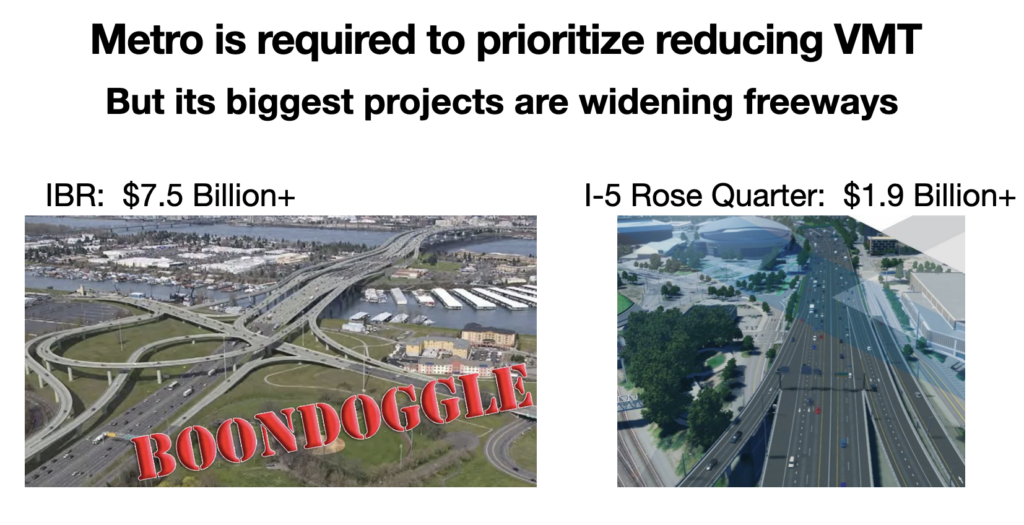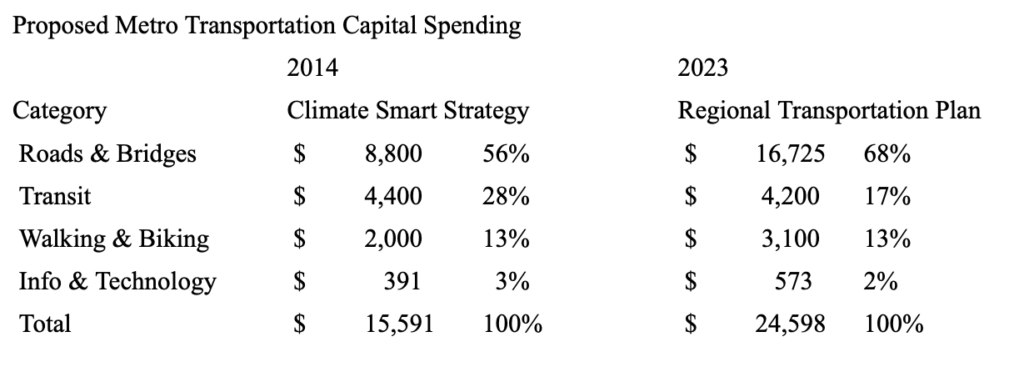Oregon’s planning rules require Portland area transportation plans to prioritize investments that reduce vehicle miles traveled
Metro’s adopted Regional Transportation Plan devotes most of its resources to providing additional capacity for car travel
Metro’s own climate analysis shows investments in roads are the least effective way to reduce greenhouse gas emissions. Transit, biking, walking and compact development are all more effective and cost effective
The share of RTP funding going to support cars and driving increased from 56 percent in the 2014 Climate Smart Strategy to 68 percent in the 2023 RTP.
By devoting more funds to cars and driving, Metro’s RTP is short-changing transit, biking and walking, all of which lower carbon emissions.
Metro’s RTP is subject to review by the Land Conservation and Development Commission, which should reject the RTP
Metro’s Regional Transportation Plan (RTP) is required to comply with state plans to reduce greenhouse gas emissions and vehicle miles traveled (VMT). The RTP fails to prioritize transportation facilities based on greenhouse gas emission reductions and VMT reduction, which is required by Oregon Administrative Rule (OAR) 660-012-0155.
- Metro’s own Climate Smart Strategy rates road projects as the least effective way to reduce greenhouse gases among policy alternatives evaluated.
- Despite this, the RTP allocates the majority of its capital spending to road and bridge projects (68% in the 2023 plan), which are least effective for reducing emissions.
- The RTP does not analyze or prioritize individual projects based on their impact on greenhouse gas emissions or VMT reduction. Instead, it only considers compliance with emission reduction goals for the overall plan.
- The document argues that this approach violates Goal 12 and its implementing rules, which require prioritization of facilities and services that reduce per-capita VMT to meet greenhouse gas targets.
- While the RTP claims VMT reduction is a “controlling measure,” in practice it prioritizes travel speed over VMT or greenhouse gas reduction when selecting projects.
Metro’s RTP fails to make progress toward state-mandated greenhouse gas reduction goals and violates state land use rules.
State regulations require rrioritizing spending on Investments that reduce driving and greenhouse gases
In 2022, the State Land Conservation and Development Commission adopted its “Climate Friendly and Equitable Communities” (CFEC) rules to implement state greenhouse gas reduction plans. These rules require Metro to develop plans to reduce driving and greenhouse gases. One part of these rules requires that transportation plans prioritize investments that reduce driving and greenhouse gases.
Specifically, OAR 660-012-0155 directs Metro to prioritize transportation facilities and services based on meeting greenhouse gas reduction goals, which provides, in relevant part:
(1) Cities, counties, Metro, and state agencies shall use the framework in this rule for decision making regarding prioritization of transportation facilities and services. Cities, counties, Metro, and state agencies shall consider the following:
(a) Prioritization factors as provided in section (3);
***
(3) Cities, counties, Metro, and state agencies shall prioritize transportation facilities and services based on the following factors:
(a) Meeting greenhouse gas reduction targets, including:
(A) Reducing per-capita VMT to meet greenhouse gas reduction targets provided in OAR 660-044-0020 or OAR 660-044-0025.
(B) Supporting compact, pedestrian-friendly patterns of development in urban areas, particularly in climate-friendly areas;
(C) Reducing single-occupant vehicle travel as a share of overall travel; and
(D) Meeting performance targets set as provided in OAR 660-012-0910.
Taken together, the provisions of OAR 660-012-0155 direct Metro to prioritize facilities and services that reduce per-capita VMT to meet greenhouse gas targets.
Metro’s own analysis show spending on roads is the least effective way to reduce greenhouse gases
Different transportation investments have varying effects on vehicle miles traveled and greenhouse gas emissions. Some investments investments enable and encourage less driving, while others, like road expansion, inevitably trigger increased driving and more greenhouse gas emissions. As part of its Climate Smart Strategy, and subsequent Regional Transportation Plans, Metro prepared a report analyzing the climate benefit of different transportation policies and investments. This report found that spending on roads was the least effective way to reduce greenhouse gases of any of the policies it examined. In its report, Metro found:
EXPLANATION OF THE CLIMATE BENEFIT RATINGS
In Phase 1 of the project, staff conducted a sensitivity analysis to better understand the greenhouse gas emissions reduction potential of individual policies. The information derived from the sensitivity analysis was used to develop a simplified five-star rating system for communicating the relative climate benefit of different policies.
Metro developed a “star” system for rating policies according to this analysis:
|
Policy |
Description |
Relative Climate Benefit |
|
Land Use |
Implement adopted local and regional land use plans |
5 Star |
|
Transit |
Make transit convenient, frequent, accessible and affordable |
5 Star |
|
Parking |
Make efficient use of vehicle parking and land dedicated to parking |
4 Star |
|
Walk/Bike |
Make biking and walking safe and convenient |
3 Star |
|
TDM |
Use technology to actively manage the transportation system |
2 Star |
|
Info. |
Provide information and incentives to expand the use of travel options |
3 Star |
|
Roads |
Make streets and highways safe, reliable and connected |
1 Star |
This analysis rates maintaining and expanding roadways as less than 1 percent, the lowest of any of the measures it evaluated (Climate Smart Strategy, page 17). Metro’s analysis concluded:
Roads: Relative to the other policy areas tested during Phase 1, the Roads policy area in Metropolitan GreenSTEP had the smallest effect on reducing regional greenhouse gas.
Metro’s RTP prioritizes projects that won’t decrease VMT
The RTP spends the bulk of its capital on projects that add capacity to freeways. The RTP’s largest projects include the $7.5 billion Interstate Bridge Replacement project and the $1.9 billion I-5 Rose Quarter expansion project, as well as other capacity expansion projects. Metro allocates the bulk of its funding to roads, the least effective measure for reducing vehicle miles traveled and greenhouse gas emissions.
More than two-thirds of the capital spending in Metro’s recently adopted 2023 Regional Transportation Plan goes to constructing roads and bridges. This is an significant increase in the priority for road and bridge spending from the 2014 Climate Smart Strategy. Rather than putting a higher priority on transit, biking and walking (as required by state regulations), Metro has actually reduced the share of RTP funding that goes to these activities.
Sources:
Metro, Climate Smart Strategy, 2014
Pages 11-23 (Capital Cost Estimates) https://www.oregonmetro.gov/sites/default/files/2015/05/29/ClimateSmartStrategy-Final Version-2014.PDF
Metro, Regional Transportation Plan, 2023
Executive Summary: Capital Projects by the Numbers (page 14) https://www.oregonmetro.gov/sites/default/files/2023/08/01/2023-RTP-Executive-summa ry-20230731.pdf
According to the Regional Transportation Plan, the Portland Area is failing to make planned progress in lower carbon transportation modes. For example, biking lags well below planned levels: RTP Appendix J, Table 4 reports that bike trips and bike miles traveled per capita declined by 50% between 2010 and 2020. The RTP fails to prioritize biking and other transportation investments and policies that are more effective in reducing greenhouse gas emissions.
If Metro were to actually comply with the prioritization requirements of the Climate Friendly and Equitable Communities Rule, it would devote more funding to transit, biking and walking, investments that according to Metro’s own analysis are more effective in reducing driving and greenhouse gases than spending on roads. Instead, Metro has done the opposite–increasing the share of funding going to the investments that are least effective in reducing greenhouse gas emissions.
Metro’s RTP violates state requirements to prioritize investments that reduce driving and greenhouse gases
Oregon’s Climate Friendly and Equitable Communities rules require Metro to prioritize those investments that will reduce driving and help lower greenhouse gases. Metro’s own analysis shows that spending on roads is the least effective way to reduce GHGs and that transit, biking, walking and compact development are far more effective. Metro’s latest RTP devotes most of its investment to roads and bridges, and has actually increased the share of investment that goes to support cars and driving compared to a decade ago.


